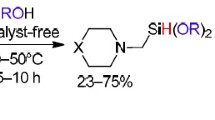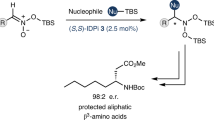Abstract
Stereochemistry in silylation reactions of alcohols, silanols, and methoxysilanes with optically pure (R)-methyl(1-naphthyl)phenylsilane were studied in the presence of Lewis acid catalysts. Tris(pentafluorophenyl)borane [B(C6F5)3] was found to be highly reactive and stereoselective in the reactions. Optically active (R)-(alkoxy)methyl(1-naphthyl)phenylsilanes with 91–97% ee were produced from alcohols through the inversion stereochemistry of the silane. Stereoselectivity in the reaction with triphenylsilanol was moderate (64% ee). (R)-1,3-Dimethyl-1-(1-naphthyl)-1,3,3-triphenyldisiloxane with 94% ee was obtained from the silane with (methoxy)methyldiphenylsilane. The reaction with (R)-(methoxy)methyl(1-naphthyl)phenylsilane (88% ee) gave (R, R)-1,3-dimethyl-1,3-di(1-naphthyl)-1,3-diphenyldisiloxane [(R, R):(R, S):(S, S) = 87:12:0.5]. The stereochemistry was proved to almost completely inversion and retention for the chiral silicon centers of the silane and methoxysilane, respectively.
Similar content being viewed by others
References
(a) Mori, A., Hishida, T., Soga, Y. & Kawakami, Y. 1995 A Facile Synthesis of Disiloxanes with Functional Groups, Chem. Lett. 107–108; (b) Mori, A., Sato, H., Mizuno, K., Hiyama, T., Shintani, K. & Kawakami, Y. 1996 A Facile Preparation and Polymerization of 1,1-Difunctionalized Disiloxanes, Chem. Lett. 517–518; (c) Kawakami, Y., Aoki, T., Hisada, H., Yamamura, Y. & Yamashita, Y. 1985 Poly(p-disiloxane substituted styrene)s as materials for oxygen permeable membranes, Polym. Commun. 26, 133–136; (d) Kawakami, Y., Karasawa, H., Kamiya, H. & Yamashita, Y. 1986 The role of p-oligosiloxane substituents of polystyrene in selective oxygen permeation through the polymer film, Polym. J. 18, 237–241; (e) Kawakami, Y., Kishimoto, N., Takeshita, K. & Watanabe, T. 1999 Relaxation study of poly[(4-oligodimethylsiloxanyl)styrene]s by solid state 29Si NMR′, Design Monom. Polym. 2, 93–101; (f) Cho, Y. H., He, M., Kim, B. K. & Kawakami, Y. 2004 Improvement of holographic performance by Novel photopolymer systems with siloxane-containing epoxides, Sci. Tech. Adv. Mater. 5, 319–323; (g) He, M., Cho, Y.H., Kim, N. & Kawakami, Y. 2005 Transmission holographic gratings using (siloxane and mesogen)-containing compounds, Design. Monom. Polym. 8, 473–486; (h) Cho, Y.H., Kawade, R., Kubota, T. & Kawakami, Y. 2005 Control of morphology and diffraction efficiency of holographic gratings using siloxane-containing reactive diluent, Sci. Tech. Adv. Mater. 6, 435–442; (i) Cho, Y.H., Shin, W., Kim, N., Kim, B.K. & Kawakami, Y. 2005 High-performance transmission holographic gratings via different polymerization rates of dipentaerythritol acrylates and siloxane-containing epoxides, Chem. Mater. 17, 6263–6271; (j) Kawakami, Y., Cho, Y.H., He, M. & Xue, L. 2006 Design of polysiloxane materials for electronic applications, Mol. Cryt . Liq. Cryst. 447, 189–202.
Li, Y. & Kawakami, Y. 1999 Catalytic cross-dehydrocoupling polymerization of 1,4-bis(dimethylsilyl)benzene with water. A new approach to poly(oxydimethylsilyl)benzene, Macromolecules 32, 3540–3542.
(a) Li, Y. & Kawakami, Y. 1999 Efficient synthesis of poly(silylether)s by Pd/C and RhCl(PPh3)3 catalyzed cross-dehydrocoupling polymerization of bis(hydrosilane)s with diols, Macromolecules 32, 6871–6873; (b) Li, Y. & Kawakami, Y. 1999 Synthesis and properties of polymers containing silphenylene moiety via catalytic cross-dehydrocoupling polymerization of 1,4-Bis(dimethylsilyl)benzene, Macromolecules 32, 8768–8773.
(a) Zhang, R., Pinhas, A.R. & Mark, J.E. 1997 Synthesis of poly(tetramethyl-m-silphenylenesiloxane), an elastomer of enhanced high-temperature stability, Macromolecules 30, 2513–2515; (b) Zhang, R., Mark, J.E. & Pinhas, A.R. 2000 Dehydrocoupling polymerization of bis-silanes and disilanols to poly(silphenylenesiloxane) as catalyzed by rhodium complexes, Macromolecules 33, 3508–3510; (c) Homrighausen, C.L. & Keller, T.M. 2002 Synthesis of hydroxy-terminated, oligomeric poly(silarylene disiloxane)s via rhodium-catalyzed dehydrogenative coupling and their use in the aminosilane-disilanol polymerization reaction, J. Polym. Sci.: Part A: Polym. Chem. 40, 1334–1341.
(a) Pike, R.M. 1961 J. Polym. Sci. 50, 151; (b) Babu, G.N. & Newmark, R.A. 1991 Polymerization of 1,4-bis(hydroxydimethylsilyl)benzene with (dimethylamino)/chlorosilanes: Structural characterization by silicon-29 NMR, Macromolecules 24, 4503–4509.
Gilman, H., Dunn, G.E., Hartzfeld, H. & Smith, A.G. 1955 The piperidine-catalyzed reaction of triphenylsilane with some hydroxy compounds, J. Am. Chem. Soc. 77, 1287–1288.
Klingler, R. J., Krause, T. R. & Rathke, J.W. 1988 Silane-silanol dehydrocondensation. The microscopic reverse of hydrogen activation by an organometallic oxide complex, J. Organomet. Chem. 352, 81–94.
(a) Corriu R.J.P., Guerin C. & Moreau J.J.E. 1989 Dynamic stereochemistry at silicon, chapt 4, p 305-370 in The Chemistry of Organic Silicon Compounds, Part I, Patai S. & Rappoport E. (Eds.), John Wiley & Sons, New York; (b) Corriu R.J.P., Guerin C., Moreau J.J.E. 1984 Top. Stereochem.15, 43.
Oishi, M. & Kawakami, Y. 1999 A stereoselective approach to optically active bifunctional 1,3-Dimethyl-1,3-diphenyldisiloxanes, Org. Lett. 1, 549–552.
(a) Oishi, M., Moon, J. Y., Janvikul, W. & Kawakami, Y. 2001 Synthesis of poly(methylphenylsiloxane) rich in syndiotacticity by Rh-catalyzed stereoselective cross-dehydrocoupling polymerization of optically active 1,3-Dimethyl-1,3-diphenyldisiloxane derivatives, Polym. Int. 50, 135–143; (b) Oishi, M. & Kawakami, Y. 2000 Synthesis of stereoregular and optically active polysiloxanes containing 1,3-Dimethyl-1,3-diphenyldisiloxane as a constitutional unit, Macromolecules 33, 1960–1963; (c) Seino, M., Oishi, M., Imae, I. & Kawakami, Y. 2002 Formation of poly(silsesquioxane) gel containing optically active 1,3-Dimethyl-1,3-diphenyldisiloxane as a connecting unit', Polym. J. 34, 43–47.
(a) Rubinsztajn, S. & Cella, J.A. 2004 Formation of siloxane bonds via new condensation process. Polym. Preprints 45, 635–636; (b) Zhou, D.Q. & Kawakami, Y. 2005 Tris(pentafluorophenyl)borane as a superior catalyst in the synthesis of optically active SiO-containing polymers, Macromolecules 38, 6902–6908; (c) Chojnowski, J., Rubinsztajn, S., Cella, J.A., Fortuniak, W., Cypryk, M., Kurjata, J. & Kazmierski, K. 2005 Mechanism of the B(C6F5)3-catalyzed reaction of silyl hydrides with alkoxysilanes. Kinetic and spectroscopic studies, Organometallics 24, 6077–6084.
Sommer, L.H. & Frye, C.L. 1959 Optically active organosilicon compounds having reactive groups bonded to asymmetric silicon. Displacement reactions at silicon with pure retention and pure inversion of configuration, J. Am. Chem. Soc. 81, 1013.
Citron, J.D. 1975 Preparation, resolution and dynamic stereochemistry of the 7H-7-Methyl-7-Silabenz[d,e]anthracene system, J. Organomet. Chem. 86, 359–367.
(a) Kawakami, Y., Takahashi, T., Yada, Y. & Imae, I. 1998 Synthesis of optically active allylhydromethylphenylsilane and elucidation of the stereochemical pathway to give isotactic poly(methylphenylsilylenetrimethylene), Polym. J. 30, 1001–1003; (b) Kawakami, Y. & Imae, I. 1999 Functionality and stereochemical design of silicon-containing polymers, Macromol. Chem. Phys. 200, 1245–1256.
Shinke, S. & Kawakami, Y. 2001 Chromatographic separation of asymmetric organosilicon compounds on cellulose and amylose stationary phases. The stereochemistry of functional transformation reactions, Chromatographia 53, 140–146.
(a) Parks, D.J., Blackwell, J. M. & Piers, W.E. 2000 Studies on the mechanism of B(C6F5)3-catalyzed hydrosilation of carbonyl functions, J. Org. Chem. 65, 3090–3098; (b) Blackwell, J.M., Foster, K.L., Beck, V.H. & Piers, W.E. 1999 B(C6F5)3-catalyzed silation of alcohols: A mild, general method for synthesis of silyl ethers, J. Org. Chem. 64, 4887–4892.
Author information
Authors and Affiliations
Corresponding author
Rights and permissions
About this article
Cite this article
Shinke, S., Tsuchimoto, T. & Kawakami, Y. Stereochemistry in Lewis acid-catalyzed silylation of alcohols, silanols, and methoxysilanes with optically active methyl(1-naphthyl)phenylsilane. Silicon Chem 3, 243–249 (2007). https://doi.org/10.1007/s11201-007-9026-y
Received:
Accepted:
Published:
Issue Date:
DOI: https://doi.org/10.1007/s11201-007-9026-y




